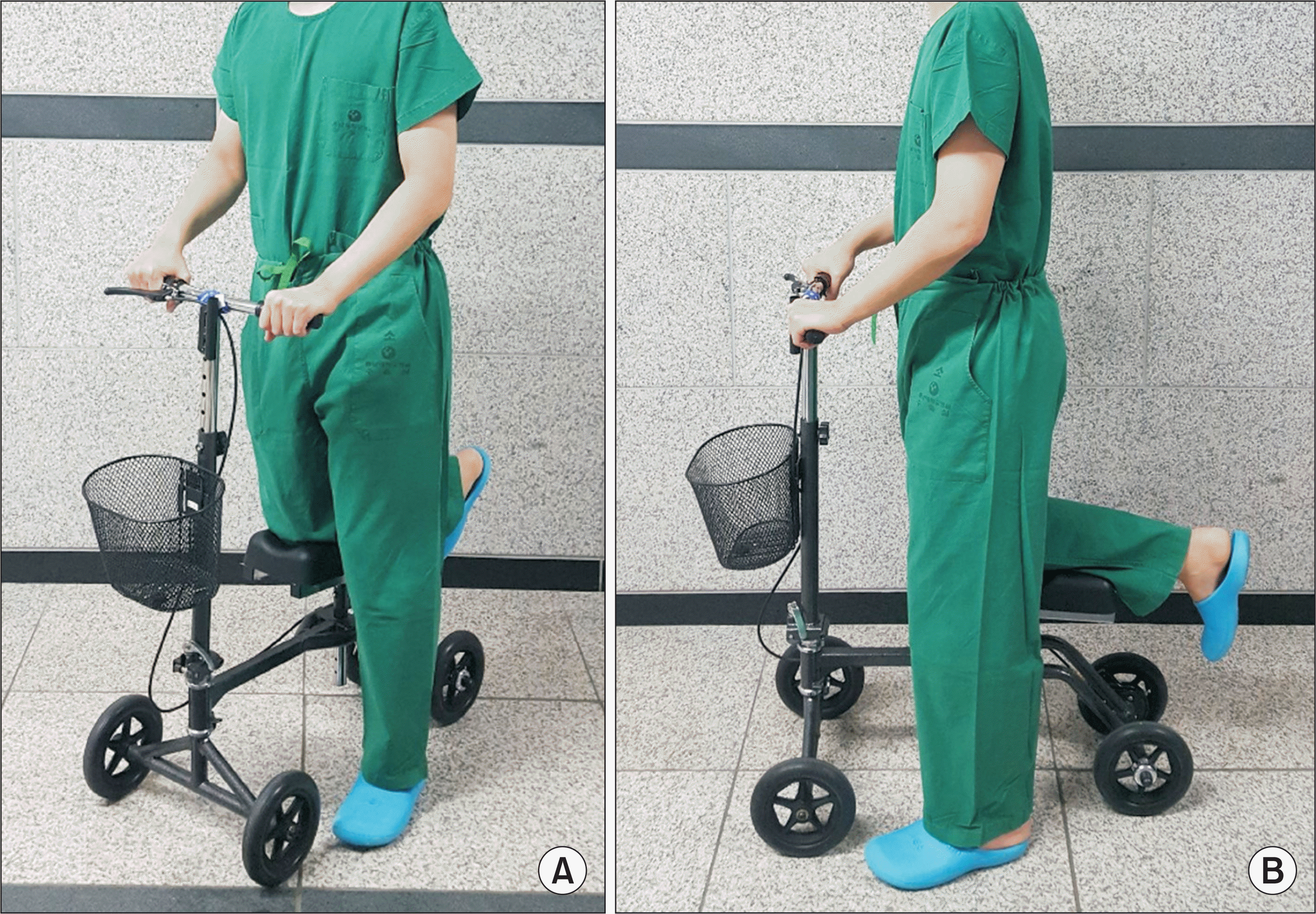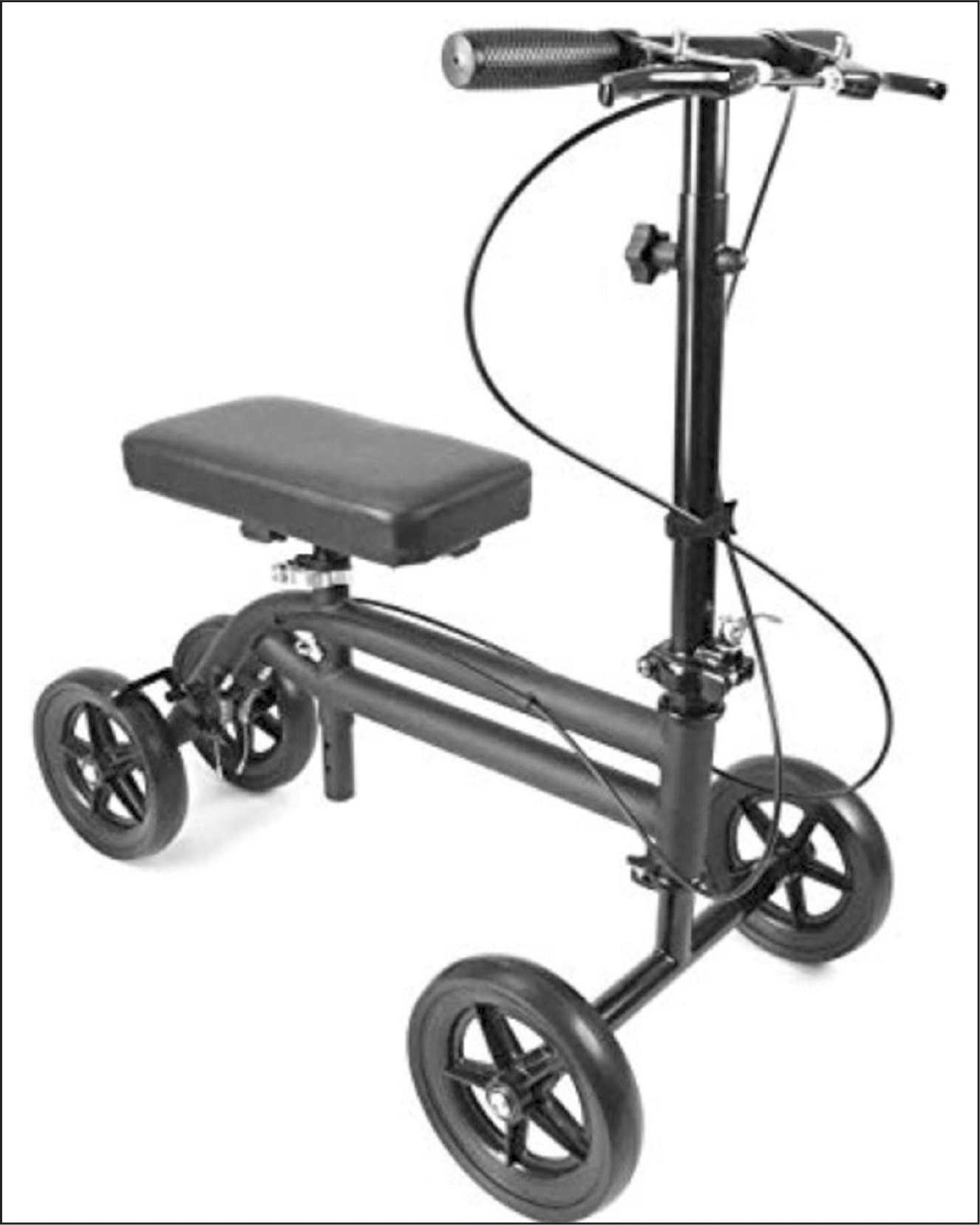Abstract
Purpose
An axillary crutch is the most commonly used assistive device in foot and ankle patients who require nonweightbearing. On the other hand, its use frequently induces axillary or wrist pain and critical neurovascular injuries have been reported in several studies. This study compared the clinical outcomes of patients using the knee walker and axillary crutch.
Materials and Methods
A retrospective analysis was performed comparing the utility of a knee walker and axillary crutch as a non-weightbearing ambulatory aid for 62 foot and ankle patients treated between November 2016 and March 2018. A comparative study of the two orthosis could be performed because all the patients temporarily used an axillary crutch before or after the use of a knee walker. A demographic study and comparative analysis based on the visual analogue scale (VAS) satisfaction score (0∼100), complications, and fall down history were evaluated. Furthermore, under the assumption of having retreatment, their preference of orthosis between the knee walker and axillary crutch was investigated.
Results
The mean age of the patients was 36.5 and the mean duration of ambulation with a knee walker and axillary crutch were 5.2 and 2.4 weeks. The VAS satisfaction score of the knee walker and crutch was 88.8 and 27.5, respectively (p<0.05). The most frequent complications of the knee walker and crutch were ipsilateral knee pain (6 cases) and axillary or wrist pain (56 cases), respectively. No case of falling down occurred during knee walker ambulation, but there were two cases of crutch ambulation. Fifty-eight patients (93.5%) preferred the knee walker and four patients (6.5%) preferred a crutch.
Go to : 
References
1. ATS Committee on Proficiency Standards for Clinical Pulmonary Function Laboratories. ATS statement: guidelines for the six-minute walk test. Am J Respir Crit Care Med. 2002; 166:111–7.
2. VanSwearingen JM, Brach JS. Making geriatric assessment work: selecting useful measures. Phys Ther. 2001; 81:1233–52.

3. Faruqui SR, Jaeblon T. Ambulatory assistive devices in orthopaedics: uses and modifications. J Am Acad Orthop Surg. 2010; 18:41–50.

4. Russell JN, Hendershot GE, LeClere F, Howie LJ, Adler M. Trends and differential use of assistive technology devices: United States, 1994. Adv Data. 1997; 292:1–9.
5. Ogunlusi JD, Davids T, Edward S, Codrington K, Fausette G. Bilateral wrist drop complicating axillary crutches mobilization in a young adult. West Indian Med J. 2013; 62:548–51.

6. Raikin S, Froimson MI. Bilateral brachial plexus compressive neuropathy (crutch palsy). J Orthop Trauma. 1997; 11:136–8.

8. Poddar SB, Gitelis S, Heydemann PT, Piasecki P. Bilateral predominant radial nerve crutch palsy: a case report. Clin Orthop Relat Res. 1993; 297:245–6.
9. Murphy MT, Journeaux SF. Case reports: long thoracic nerve palsy after using a single axillary crutch. Clin Orthop Relat Res. 2006; 447:267–9.

10. Abbott WM, Darling RC. Axillary artery aneurysms secondary to crutch trauma. Am J Surg. 1973; 125:515–20.

11. Brooks AL, Fowler SB. Axillary artery thrombosis after prolonged use of crutches. J Bone Joint Surg Am. 1964; 46:863–4.

12. Basílio MdR. Cantador AA, Molinari GJDP, Menezes FH. Crutch-related acute arterial thrombosis in upper limb: case report. J Vasc Bras. 2014; 13:340–4.
13. de Luccia N, Albers M, Wolosker M. [Axillary artery aneurysm due to the use of crutches]. Rev Paul Med. 1979; 94:87–9. Portuguese.
14. Schramek A, Hashmonai M, Abrahamson J. Axillary artery thrombosis due to crutch trauma. Angiology. 1974; 25:467–9.

15. Konishi T, Ohki S, Saito T, Misawa Y. Crutch-induced bilateral brachial artery aneurysms. Interact Cardiovasc Thorac Surg. 2009; 9:1038–9.

16. Moon IS, Hwang JK, Kim JI. Recurrent upper extremity embolism due to a crutch-induced arterial injury: a different cause of upper extremity embolism. Ann Vasc Surg. 2010; 24:554.e7–12.

17. Furukawa K, Hayase T, Yano M. Recurrent upper limb ischaemia due to a crutch-induced brachial artery aneurysm. Interact Cardiovasc Thorac Surg. 2013; 17:190–2.

18. Kocher BK, Chalupa RL, Lopez DM, Kirk KL. Comparative study of assisted ambulation and perceived exertion with the wheeled knee walker and axillary crutches in healthy subjects. Foot Ankle Int. 2016; 37:1232–7.

19. Coughlin MJ. Arthrodesis of the first metatarsophalangeal joint with mini-fragment plate fixation. Orthopedics. 1990; 13:1037–44.

20. Goh JC, Toh SL, Bose K. Biomechanical study on axillary crutches during single-leg swing-through gait. Prosthet Orthot Int. 1986; 10:89–95.

21. McFall B, Arya N, Soong C, Lee B, Hannon R. Crutch induced axillary artery injury. Ulster Med J. 2004; 73:50–2.
22. Steffen TM, Hacker TA, Mollinger L. Age- and gender-related test performance in community-dwelling elderly people: six-minute walk test, berg balance scale, timed up & go test, and gait speeds. Phys Ther. 2002; 82:128–37.
Go to : 
 | Figure 2.The images of male using knee walker are shown. (A) Oblique image. (B) Lateral Image. |
Table 1.
Demographics Data of the Study (n=62)
Table 2.
Cases of Knee Walker (n=62)




 PDF
PDF ePub
ePub Citation
Citation Print
Print



 XML Download
XML Download